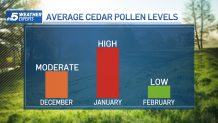Feeling a bit under the weather? It might not be a virus, it could be cedar fever!
Cedar first popped up on our allergy counts in early November. While levels thus far have been low, levels usually jump into the moderate category by mid-December and eventually peak in January.

"The pollen from Ashe junipers isn’t particularly allergenic or harmful – it’s just so concentrated that, even if you aren’t generally susceptible to allergies, it could still affect you. With millions of juniper trees releasing pollen at the same time, you can’t help but breathe it in, and when you do, your body reacts as it would to any perceived threat – it tries to fight it," said Jonathan Motsinger, Texas A&M Forest Service Central Texas Operations Department Head.
Get top local stories in DFW delivered to you every morning. Sign up for NBC DFW's News Headlines newsletter.
Cedar and juniper trees grow and pollinate during the winter in the southern U.S. A large number of the cedar and juniper trees in Texas are in the Hill Country and East Texas. When winds are from the south, the pollen travels to North Texas. Wind can carry cedar or juniper pollen for miles.
“During cold fronts, it gets very dry and windy and the pressure changes very rapidly,” said Motsinger. “This triggers the opening of pollen cones and the release of the pollen grains. When the conditions are right, you can actually see the pollen blowing off of some trees.”

South winds will make a return in the week ahead, bringing another round of the pesky allergen to North Texas.
Local
The latest news from around North Texas.
Aside from taking allergy medications, it’s also recommended to keep windows and doors closed and to limit the amount of time you spend outdoors if you are susceptible to the allergen. It can also be helpful to change air filters in your car and in your home as a clean, new filter is better at removing particles, like pollen, from the air.
For more information about how to identify Ashe junipers and/or eastern redcedars in your backyard, check out the Texas A&M Forest Service’s Texas Tree ID webpage or the My Tree ID mobile app. You can also see the distribution of junipers, as well as a variety of other tree species across the state, via our Forest Distribution App.



